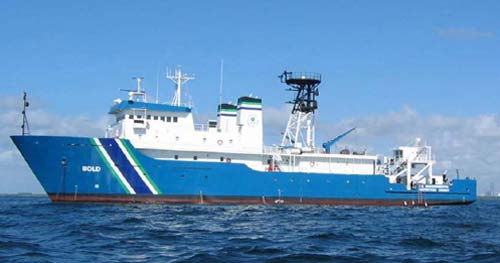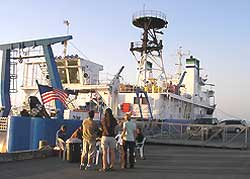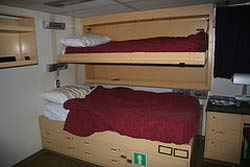At Sea with the Bold: Waterworld…The Bold Basics
Posted on September 29th, 2008 - 10:30 AM
This week we’re focusing on OSV Bold, one of EPA’s research ships. Two usually shore-based EPA staffers, Margot Perez-Sullivan and Margaret Ford, went out on the ship with the researchers a couple of weeks ago with one goal: come back and share what it’s like. They wrote and photographed each day, but had no Internet access at sea, so we’re posting their blog entries this week. And the EPA folks will read and respond to comments all week. We’ll resume our usual blog features next week: Question of the Week, Science Wednesday, and Lina’s multilingual musings. Let us know whether this kind of in-depth reporting floats your boat! — Jeffrey Levy, Greenversations editor.
Day 1 (9.5.08):
I’ve never been on a cruise. Never spent the night on a boat…at best it was a ferry here and there or the random tourist trap night cruise. When I found out I was invited to tag along and document science and research in action on the EPA’s Ocean Survey Vessel (OSV) Bold, I was thrilled. And a little scared.
The EPA uses the OSV Bold to monitor coastal waters throughout the United States. This summer marks the Bold’s maiden voyage to the west coast and this is her last survey before returning to the eastern seaboard. The Bold has an enormous mission and its surveys are carefully planned to maximize monitoring and research year-round. The Bold is 224 feet long, has a full crew of 18 and can accommodate up to 19 scientists on any one survey.
Our west coast scientists are excited to have the research vessel on this side of the country and are taking every opportunity possible to get out to sea and conduct research and sampling surveys on the Pacific.
 A team of nine scientists descended upon Eureka, California this September and began mobilizing for the upcoming Humboldt Open Ocean Disposal Site (HOODS) survey. HOODS is an ocean disposal site for dredged materials. West coast ports are the gateway to Asia; the Port of Los Angeles alone receives 50% of the nation’s foreign goods. These mega ships need deep ports to come into, which is where dredging and ocean disposal sites come into play. In a nut shell, sites like HOODS receive sands and sediments from local ports that need to move this material to make sure large ships can come into ports. A sediment testing program is in place to make sure that only clean, nontoxic sediments are taken to HOODS.
A team of nine scientists descended upon Eureka, California this September and began mobilizing for the upcoming Humboldt Open Ocean Disposal Site (HOODS) survey. HOODS is an ocean disposal site for dredged materials. West coast ports are the gateway to Asia; the Port of Los Angeles alone receives 50% of the nation’s foreign goods. These mega ships need deep ports to come into, which is where dredging and ocean disposal sites come into play. In a nut shell, sites like HOODS receive sands and sediments from local ports that need to move this material to make sure large ships can come into ports. A sediment testing program is in place to make sure that only clean, nontoxic sediments are taken to HOODS.
That said, during this survey, scientists are taking samples to determine the chemistry of HOODS’ sediments to confirm that the sediment testing is accurate, ensuring the sand and sediment material being dumped from the ports meets EPA standards, meaning it’s clean and doesn’t negatively impact the ecosystem near the site. Our scientists are also documenting the presence of benthic organisms (tiny sea critters that live on the ocean floor) in and around the HOODS disposal site. The results will be put together to make sure the HOODS site is being taken care of properly. VIDEO: Scientist Brian Ross discusses the survey plan.
For our marine biologists, the benthic samples will give them a good idea of the health of the ocean floor. There is a direct correlation between the types and health of these tiny ocean floor critters and the overall ocean floor environment.
 We’ve got nine environmental scientists on this survey with over 5 decades of education combined. Our nine environmental scientists are: Allan Ota, ocean disposal site expert and co-Chief Scientist; Brian Ross, ocean disposal site expert; Amy Wagner, marine biologist; Greg Nagle, chemist; Kevin Ryan, drinking water expert; Tina Yin, watersheds expert; Eugenia McNaughton, Ph.D in algae plankton and quality assurance guru; Carolyn Yale, Ph.D. watershed planner; and Chris McArthur, Chief Scientist from our Atlanta regional office.
We’ve got nine environmental scientists on this survey with over 5 decades of education combined. Our nine environmental scientists are: Allan Ota, ocean disposal site expert and co-Chief Scientist; Brian Ross, ocean disposal site expert; Amy Wagner, marine biologist; Greg Nagle, chemist; Kevin Ryan, drinking water expert; Tina Yin, watersheds expert; Eugenia McNaughton, Ph.D in algae plankton and quality assurance guru; Carolyn Yale, Ph.D. watershed planner; and Chris McArthur, Chief Scientist from our Atlanta regional office.
Margaret Ford our videographer and I are on board to document the survey.
We arrived this evening and got our room assignments, a short orientation of the survey schedule and a walk around the work areas with Allan. Often, to maximize time at sea, Bold surveys run on 24-hour operations, luckily we are only on 8 hour shifts for this survey. VIDEO: See our arrival.
We are scheduled to push off tomorrow afternoon…
What did you know about ocean research BEFORE you read this blog?
Total Voters: 149 |
Tags: BOLD Research Vessel, ocean, Research
| Permalink | TrackBack
September 29th, 2008 at 11:30 am
Looking forward to your Bold series. I know very little of the important work EPA does in surveying out oceans. In terms of analyzing the environmental conditions in the deep seas, basically know what I’ve seen in the movies or some specials on the Discovery Channel. I’m curious to see what our shore-based staffers report back.
[Reply]
September 30th, 2008 at 10:12 am
I never knew that this ship was an EPA research vessel. can you tell me how many and what type of engines it uses ( mfg.,hp,model,gph)
[Reply]
Margot Perez-Sullivan reply on September 30, 2008 2:17 pm:
Hi Jim:
Here’s what I know. There are 4 diesel generators, 2 general electric, electric motors w/ 800 horsepower each, 70 gph generator.
[Reply]
October 1st, 2008 at 12:17 am
This is great content. I love that you have video, too.
[Reply]
October 3rd, 2008 at 4:03 pm
I think your reports by shore staff are invaluable. I’m very impressed with the reporting and with the project.
As a taxpayer, I am thrilled to be able to read such a compelling first-hand report of a manageable and sustainable project.
Please keep the great writing coming!
P. Perez
[Reply]
January 30th, 2009 at 5:30 pm
As a University of Miami graduate student taking an environmental health course, I was interested in seeing your blog post on the HOODS site and the survey being conducted on the site by scientists. I noticed in your article that the HOODS survey evaluated the chemistry of sediments dredged from local west coast ports as meeting EPA standards. However, these sediments could contain microorganisms that could affect the ecosystem that the HOODS disposal site is within. Has the sediment testing done in the survey included analyzing the microorganisms in these sands and their potential impact on the HOODS’ site?
[Reply]
February 26th, 2009 at 10:42 pm
As a University of Miami graduate student taking an environmental health course, I was interested in seeing your blog post on the HOODS site and the survey being conducted on the site by scientists. I noticed in your article that the HOODS survey evaluated the chemistry of sediments dredged from local west coast ports as meeting EPA standards. However, these sediments could contain microorganisms that could affect the ecosystem that the HOODS disposal site is within. Has the sediment testing done in the survey included analyzing the microorganisms in these sands and their potential impact on the HOODS’ site?
Thank you for your time.
[Reply]